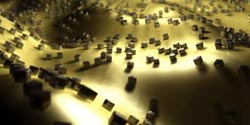Silver nanocubes make super light absorbers

These are nanocubes.<br>Credit: Cristian Ciraci
Metamaterials are man-made materials that have properties often absent in natural materials. They are constructed to provide exquisite control over the properties of waves, such as light. Creating these materials for visible light is still a technological challenge that has traditionally been achieved by lithography, in which metallic patterns are etched onto an inert material, much like an ink-jet printer.
As effective as lithography has been in creating such structures, it does have a limitation – it is very expensive and thus difficult to scale up to the large surface areas required for many applications.
“Our new approach is more of a bottom-up process,” said Cristian Ciracì, research scientist at Duke's Pratt School of Engineering. “It may allow us to create devices – such as efficient solar panels – that cover much larger areas. In our experiments, we demonstrated an extraordinarily simple method to achieve this.”
The results of Ciracì and co-workers' experiments, which were conducted in the laboratory of senior researcher David R. Smith, William Bevan Professor of electrical and computer engineering at Duke, were published Dec. 6 in the journal Nature.
For many applications or devices, the key is the material's ability to control the absorption of electromagnetic waves. Metals, for example, can be highly reflective on their own, which may be beneficial for some applications, but for something like a solar cell, optimal light absorption is desired.
“However, metamaterials based on metallic elements are particularly efficient as absorbers because both the electrical and magnetic properties of the material can be controlled by how we design them,” Ciracì said.
The new metamaterial developed by the Duke team has three major components – a thin layer of gold film coated with a nano-thin layer of an insulator, topped off with a dusting of millions of self-assembled nanocubes. In the current experiments, the nanocubes were fabricated out of silver.
“The nanocubes are literally scattered on the gold film and we can control the properties of the material by varying the geometry of the construct,” Ciracì said. “The absorptivity of large surface areas can now be controlled using this method at scales out of reach of lithography.”
While metals on their own tend to have reflective properties, the nanocubes act as tiny antennae that can cancel out the reflectance of the metal surface.S
“By combining different components of the metamaterial elements together into a single composite, more complicated reflectance spectra could be engineered, achieving a level of control needed in more exotic applications, such as dynamic inks,” Ciracì said.
The research was supported by the Air Force Office of Scientific Research and by the Army Research Office's Multidisciplinary University Research Initiative (MURI).
The other members of the team were first author Antoine Moreau, Clermont University, France; Duke's Ryan Hill, Jack Mock, Benjamin Wiley and Ashutosh Chilkoti; and Qiang Wang from the Capital Normal University, Beijing.
“Controlled-reflectance surfaces with film-coupled colloidal nanoantennas,” A. Moreau, C. Ciraci, J. Mock, R. Hill, Q. Wang, B. Wiley, and A. Chilkoti. Nature, 6 Dec., 201
Media Contact
More Information:
http://www.duke.eduAll latest news from the category: Physics and Astronomy
This area deals with the fundamental laws and building blocks of nature and how they interact, the properties and the behavior of matter, and research into space and time and their structures.
innovations-report provides in-depth reports and articles on subjects such as astrophysics, laser technologies, nuclear, quantum, particle and solid-state physics, nanotechnologies, planetary research and findings (Mars, Venus) and developments related to the Hubble Telescope.
Newest articles

Superradiant atoms could push the boundaries of how precisely time can be measured
Superradiant atoms can help us measure time more precisely than ever. In a new study, researchers from the University of Copenhagen present a new method for measuring the time interval,…

Ion thermoelectric conversion devices for near room temperature
The electrode sheet of the thermoelectric device consists of ionic hydrogel, which is sandwiched between the electrodes to form, and the Prussian blue on the electrode undergoes a redox reaction…

Zap Energy achieves 37-million-degree temperatures in a compact device
New publication reports record electron temperatures for a small-scale, sheared-flow-stabilized Z-pinch fusion device. In the nine decades since humans first produced fusion reactions, only a few fusion technologies have demonstrated…





















